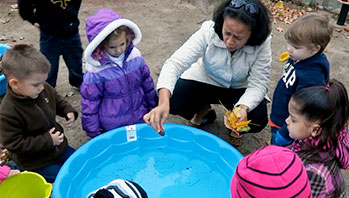- camera or cell phone with camera
- clipboard
- crayons or markers
- different size/weight objects
- drawing paper
- pen or marker, slide
- fast
- faster
- roll
- slide (n.)
- slower
- slant
MA Standards:
English Language Arts/Language/L.PK.MA.6: Use words and phrases acquired through conversations, listening to books read aloud, activities, and play.
MA Draft Standards:
Physical Sciences/Motion and Stability; Forces and Interaction/PS2.A: Plan and carry out investigations of the behaviors of moving things.
Physical Sciences/Motion and Stability; Forces and Interaction /PS2.B: Using evidence, discuss ideas about what is making something move the way it does and how some movements can be controlled. [Cause and Effect, Stability and Change]
Head Start Outcomes:
Logic and Reasoning/Reasoning and Problem Solving: Recognizes cause and effect relationships.
Science Knowledge/Scientific Skills and Method: Uses senses and tools, including technology, to gather information, investigate materials, and observe processes and relationships.
PreK Learning Guidelines:
English Language Arts/Language 2: Participate actively in discussions, listen to the ideas of others, and ask and answer relevant questions.
Explore Together (outdoors): Down the Slide

© Commonwealth of Massachusetts, Department of Early Education and Care. All rights reserved.
STEM Key Concepts: An object placed on an inclined plane will roll, slide, or stay put; The shape of an object affects whether it will roll or slide or stay put; The motion and speed of a rolling or sliding object is affected by the texture of the object and the texture of the inclined plane
ELA Focus Skills: Listening and Speaking, Vocabulary
Educator Prep: If your outside area does not have a small toddler slide, prepare a small inclined plane from a piece of wood or heavy cardboard propped against a rock, wall, etc.
Tell children that they will go outside to a slide and explore what happens when they place an object at the top of it.
Begin by gathering the objects near the slide. Have children pick up an object and describe it. Encourage them to include size, shape, weight, and texture in their descriptions. Ask questions such as,
- How is Jenna’s block different than Kareem’s block? (heavier, smaller)
- What is the same about the marker and the crayon? (size, shape)
Have children send their objects down the slide one by one and discuss how each one rolls down the slide. Then allow children to freely explore the materials. Encourage them to describe and imitate (with their hands and bodies) how different balls roll down the slide. You can prompt the discussion with questions such as,
- I noticed you made the marker go fast down the slide. How do you think you could make the marker roll faster down the slide? How about slower?
- I wonder what would happen if you started it in the middle of the slide?
- What do you think will happen if you put the big block and the little block on the slide at the same time?
Observe children as they explore and jot down any observations they make. You may want to document observations by taking pictures or video of children exploring as well, or allow children to take pictures as they explore.
Reflect and Share
Once you return to the room, invite children to share their observations. Include photos and notes and have objects on hand so children can refer to them as they speak. Ask questions such as,
- Why do the objects roll down the slanted part of the slide?
- Why do you think the marble rolled faster than the marker?
Invite children to draw a picture of a slide to reinforce what a slanted incline is.
English Language Learners: To help children grasp an understanding as to how things roll fast and slow, describe for them the motion as it is rolling down a ramp. After it reaches the bottom and you have described the motion, ask Did that <block> roll fast or slow? Use a ball and a block or eraser to model the fast and slow rolling.
Adaptation: If younger children are in the group, you might prefer to have each child do the activity individually, with one-to-one supervision.
